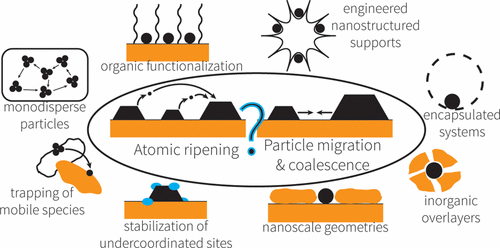当前位置:
X-MOL 学术
›
ACS Catal.
›
论文详情
Our official English website, www.x-mol.net, welcomes your
feedback! (Note: you will need to create a separate account there.)
Mechanistic Understanding and the Rational Design of Sinter-Resistant Heterogeneous Catalysts
ACS Catalysis ( IF 11.3 ) Pub Date : 2017-09-25 00:00:00 , DOI: 10.1021/acscatal.7b01975 Emmett D. Goodman 1 , Jay A. Schwalbe 1 , Matteo Cargnello 1
ACS Catalysis ( IF 11.3 ) Pub Date : 2017-09-25 00:00:00 , DOI: 10.1021/acscatal.7b01975 Emmett D. Goodman 1 , Jay A. Schwalbe 1 , Matteo Cargnello 1
Affiliation

|
The activity and selectivity of heterogeneous catalysts are strong functions of the morphology of the catalytic active phase, which governs both the density and type of active sites. To realize materials with the desired reactivity, cutting-edge catalysts are often the product of novel synthetic strategies and advanced computational studies. Combining these approaches allows for the prediction and fabrication of active motifs in a directed manner. However, catalyst active phases are ordinarily in the nanometer or atomic regime, and small morphological changes can result in large differences in catalytic properties. Given painstaking efforts to design and fabricate active materials at the nanoscale, it is essential that these engineered structures and superior catalytic properties are preserved during working conditions. The stability of a highly active catalyst morphology is crucial for long-term, sustained activity, especially for industrial applications. Unfortunately, catalyst sintering, or processes in which active surface area is lost due to irreversible agglomeration of atomic species or particles, inevitably leads to reduced active surface area and decreased catalytic activity. This problem has led to the development of many schemes, applied with varying degrees of success, which attempt to counteract these aging processes. Undoubtedly, for the directed development of stable, sinter-resistant, heterogeneous catalysts, a fundamental understanding of the species and mechanisms contributing to sintering processes is required. To highlight the importance of fundamental mechanistic understanding of sintering processes, the first portion of this perspective highlights recent approaches to characterize sintering dynamics in heterogeneous catalysts. Next, we showcase recent examples illustrating intentional measures taken to protect against particular sintering mechanisms. We believe that by reviewing examples with mechanistic understanding of these aging phenomena, we can select approaches with the highest probability of successful application to new catalytic systems. These approaches are divided into two main categories: chemical approaches, which are based on modification of the chemistry of the catalytic materials, and physical approaches, based on increased physical barriers to sintering. Our goal is to stimulate more work both on the fundamental understanding of sintering mechanisms, and on the production of stable catalysts by directly targeting and suppressing specific sintering processes.
中文翻译:

耐烧结多相催化剂的机理理解与合理设计
非均相催化剂的活性和选择性是催化活性相形态的强函数,它控制活性位点的密度和类型。为了实现具有所需反应性的材料,尖端的催化剂通常是新型合成策略和高级计算研究的产物。结合这些方法可以以定向方式预测和制造活性基序。然而,催化剂活性相通常处于纳米或原子状态,并且小的形态变化可导致催化性能的较大差异。付出艰辛的努力来设计和制造纳米级活性材料,在工作条件下保留这些工程结构和出色的催化性能至关重要。高活性催化剂形态的稳定性对于长期持续的活性至关重要,特别是对于工业应用而言。不幸的是,催化剂烧结或由于不可逆的原子种类或颗粒团聚而失去活性表面积的方法不可避免地导致活性表面积减小和催化活性降低。这个问题导致开发了许多方案,并以不同程度的成功应用,这些方案试图抵消这些老化过程。毫无疑问,要直接开发稳定,耐烧结的非均相催化剂,需要对有助于烧结过程的种类和机理有一个基本的了解。为了强调烧结过程的基本机械理解的重要性,该观点的第一部分重点介绍了表征多相催化剂中烧结动力学的最新方法。接下来,我们展示最近的示例,这些示例说明了为防止特定烧结机制而采取的有意措施。我们认为,通过回顾对这些老化现象具有机械理解的示例,我们可以选择成功应用于新催化系统的可能性最高的方法。这些方法分为两大类:基于改进催化材料化学性质的化学方法和基于增加的烧结物理障碍的物理方法。我们的目标是在对烧结机理的基本理解上激发更多的工作,
更新日期:2017-09-25
中文翻译:

耐烧结多相催化剂的机理理解与合理设计
非均相催化剂的活性和选择性是催化活性相形态的强函数,它控制活性位点的密度和类型。为了实现具有所需反应性的材料,尖端的催化剂通常是新型合成策略和高级计算研究的产物。结合这些方法可以以定向方式预测和制造活性基序。然而,催化剂活性相通常处于纳米或原子状态,并且小的形态变化可导致催化性能的较大差异。付出艰辛的努力来设计和制造纳米级活性材料,在工作条件下保留这些工程结构和出色的催化性能至关重要。高活性催化剂形态的稳定性对于长期持续的活性至关重要,特别是对于工业应用而言。不幸的是,催化剂烧结或由于不可逆的原子种类或颗粒团聚而失去活性表面积的方法不可避免地导致活性表面积减小和催化活性降低。这个问题导致开发了许多方案,并以不同程度的成功应用,这些方案试图抵消这些老化过程。毫无疑问,要直接开发稳定,耐烧结的非均相催化剂,需要对有助于烧结过程的种类和机理有一个基本的了解。为了强调烧结过程的基本机械理解的重要性,该观点的第一部分重点介绍了表征多相催化剂中烧结动力学的最新方法。接下来,我们展示最近的示例,这些示例说明了为防止特定烧结机制而采取的有意措施。我们认为,通过回顾对这些老化现象具有机械理解的示例,我们可以选择成功应用于新催化系统的可能性最高的方法。这些方法分为两大类:基于改进催化材料化学性质的化学方法和基于增加的烧结物理障碍的物理方法。我们的目标是在对烧结机理的基本理解上激发更多的工作,











































 京公网安备 11010802027423号
京公网安备 11010802027423号